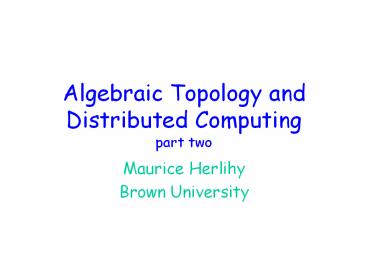Algebraic Topology and Distributed Computing part two - PowerPoint PPT Presentation
Title:
Algebraic Topology and Distributed Computing part two
Description:
A complex C is n-connected if it has no holes in dimension n or less. ... One-Round Protocol Complex. R runs solo. P and Q run solo (Some simplexes omitted for ... – PowerPoint PPT presentation
Number of Views:153
Avg rating:3.0/5.0
Title: Algebraic Topology and Distributed Computing part two
1
Algebraic Topology and Distributed Computingpart
two
- Maurice Herlihy
- Brown University
2
Proof Strategy
Find topological obstruction to this simplicial
map
d
Protocol complex
Output complex
3
Obstructions
n-sphere
(n1)-disk
4
No Holes in Dimension n
every continuous n-sphere map extends to
(n1)-disk
f
F
5
Connectivity
- A complex C is n-connected if it has no holes in
dimension n or less. - dimension -1 non-empty (by convention)
- dimension 0 connected
- dimension 1 simply connected
- (Homotopy groups are trivial.)
6
Protocol as Operator
input simplex fix m1 processes and their inputs
protocol complex only these processes take steps
7
Connectivity of P(S)
- Dimension below which holes vanish
- higher dimension
- more obstructions
- more tasks impossible
- lower dimension
- fewer obstructions
- fewer tasks impossible
8
Theorem
- synchronous message-passing model
- r rounds
- at most k failures per round
- is (n-rk1)-connected
- connectivity drops with each round
- implies (n-1)-round consensus bound
9
Shared Memory Model
10
Shared Memory Model
- Processes share memory m0n
- unbounded size (for lower bounds)
- each P can
- atomically write to mP
- atomically scan (read) all of m
- equivalent to usual read/write models
11
Asynchronous Wait-Free
- Asynchronous
- arbitrary delays
- e.g., interrupts, page faults, etc.
- wait-free
- all but one process can halt
- failed and slow indistinguishable
12
Generic R/W Protocol
Number of rounds
s empty sequence for (i0 iltr i) s
s scan(m) mP s return d(s)
Decision map
13
One-Round Protocol Complex
P runs solo
Q runs solo
P and Q see one another
14
One-Round Protocol Complex
R runs solo
(Some simplexes omitted for clarity)
P and Q run solo
15
Theorem
- Wait-Free R/W Protocol Complexes
- are n-connected
- (no holes in any dimension)
- no matter how long the protocol runs
- Next an application
16
The k-Set Agreement Task
Before private inputs
After agree on k inputs
17
Output Complex for 3-Process 2-Set Agreement
18
Set Agreement
- Proposed by Soma Chaudhuri 90
- generalization of consensus
- does wait-free R/W protocol exist?
- Open problem until 1993
- Borowsky Gafni, Herlihy Shavit, Saks
Zaharoglou
19
Proof Outline
- Assume protocol exists
- show incompatibilities between
- protocol complex
- output complex
- some execution must decide too many distinct
values
20
Sperners Lemma
- Subdivide a simplex
- give each corner a distinct color
- each edge vertex a corner color
- interior vertexes any corner color
21
Sperners Lemma
- At least one simplex has all colors
22
Input Simplex Protocol Complex
Each process colored with distinct input
Each vertex colored with decision
23
Protocol Complex for One Process Execution
P( )
- single vertex
- labeled with matching color
24
Protocol Complex for Two-Process Executions
- Protocol complex is connected
- there is a path from P( ) to P( )
- all vertexes labeled with red or yellow
P( )
25
Protocol Complexes for all Two-Process Executions
P( )
P( )
26
Full Protocol Complex
- Because complex is simply connected
- we can fill in edge paths
- vertexes colored with input colors
27
Apply Sperners Lemma
- some simplex has all three colors
- that simplex is a protocol execution that decides
three values!
28
Augmented Shared Memory
- Real multiprocessors provide additional atomic
synchronization - testset
- compareswap
- load-linked/store-conditional
29
Example TestSet
Testset(int v) int temp v v 1
return temp
First gets 0, rest get 1
30
TestSet Protocol Complex
0
- 3 processes
- First gets 0
- Rest get 1
- multi-round Sierpinski triangle
1
1
0
0
1
31
Other TestSet Protocol Complexes
Connected, not simply connected
32
Theorem
- Wait-Free TS Protocol Complexes
- are all (n-1)-connected
- more powerful than read/write
- but still no 3-process consensus!
- Similar results hold for other atomic
synchronization operations
33
Summary
- Power of model of computation
- connectivity of protocol complexes
- dimension below which holes vanish
- So far
- defined model
- one application
- Next computing connectivity































